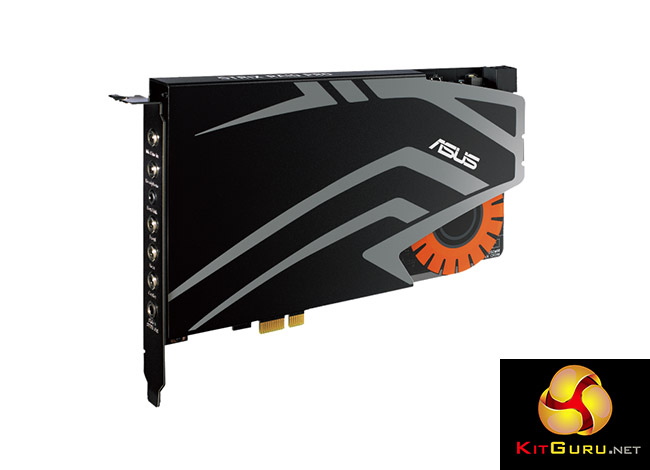Ask any PC gamer what their system specifications are and they will be able to rattle off a detailed list of numbers and brand names … however there is a good chance they will still using onboard sound. For some reason sound cards are not seen as a particularly exciting addition to a gaming PC – but ASUS wants to change that. It has been making a number of gaming focused sound cards for a while, but its new STRIX line is gunning hard for the gaming demographic who are unhappy with their audio output.
Today we look at the most affordable of the STRIX sound cards, the Soar. Although it has much the same hardware and features as its bigger brothers, it is more affordable which could be the real kicker in convincing potential buyers.
We looked at the high-end STRIX Raid Pro from the line up previously. The non-Raid version we are looking at today comes without that fancy volume control and its Raid mode features. The question is: is it still a great package without that?
Features
- 116dB signal-to-noise ratio (SNR) and audiophile-grade DAC: Enjoy high-fidelity, immersive sound.
- Sonic Studio utility: Take full control over loads of sound technologies via an intuitive, one-page interface.
- Sonic Radar Pro: Lets you pinpoint the exact location of in-game sounds and enhances critical audio details like enemy footsteps for an aural advantage.
- 600ohm headphone amplifier: For enhanced bass and clear, detailed sound.
Specifications
- Audio Interface: PCI Express.
- Output Signal-to-Noise Ratio (A-Weighted) (Front-out): 116 dB.
- Output Signal-to-Noise Ratio (A-Weighted) (Headphone-out): 110 dB.
- Input Signal-to-Noise Ratio (A-Weighted): 110 dB.
- Output THD+N at 1kHz (Front-out): 0.001 %(-100 dB).
- Output THD+N at 1kHz (Headphone-out): 0.003 %(-90 dB).
- Input THD+N at 1kHz: 0.000316 %(-110 dB).
- Frequency Response (-3dB, 24bit/96KHz input): 10 Hz to 48 KHz.
- Output/Input Full-Scale Voltage: Line output (RCA, 3.5) : 2 Vrms (5.65 Vp-p).
- Audio Processor: C-Media USB2.0 6632AX High-Definition Sound Processor (Max. 384KHz / 24bit).
- Digital-to-analog Converter (DAC): ESS SABRE9006A Premier 8 Channel Audio DAC.
- Analog Playback Sample Rate and Resolution: 44.1K/48K/88.2K/96K/176.4K/192KHz @ 16bit/24bit.
- Analog Recording Sample Rate and Resolution: 44.1K/48K/88.2K/96K/176.4K/192KHz @ 16bit/24bit.
- S/PDIF Digital Output: 44.1K/48K/96K/192KHz @ 16bit/24bit.
- ASIO 2.0 Driver Support: 44.1K/48K/96K/192KHz @ 16bit/24bit with very low latency.
 KitGuru KitGuru.net – Tech News | Hardware News | Hardware Reviews | IOS | Mobile | Gaming | Graphics Cards
KitGuru KitGuru.net – Tech News | Hardware News | Hardware Reviews | IOS | Mobile | Gaming | Graphics Cards




Just got the replacement through – EXACT SAME PROBLEM. Asus are total shit.
Same on windows 8.1 ! I thought my headphones where broken lol.
Does the new driver available on their site improves something??
They have driver for windows 10. Has the situation improved or you have got some other card?
I returned the card so sadly I wouldn’t know. Franky I’m going to always avoid Asus after this.
If you’re going to avoid companies after just one little oversight, you might as well quit technology altogether and go live in the woods. There are no faultless companies.
Kid, keep quiet as you don’t know what you’re on about. They do this all the time (just google it) and it took about 2 months and threatening to take them to court for them to resolve it. That isn’t a “little oversight”, that is incompetence verging on fraud.
Crosstalk is not caused from drivers, its from EMI from other hardware like a poor quality PSU or being put in-between two video cards. Putting the card in a DIFFERENT computer (as you did) just answered that. This is whats called an ‘underlying cause’. There’s very little a driver can do to stop crosstalk short of having the AMP run at a lower output voltage. Ironically the crosstalk is still there, but too low to be heard. Moving the card to a different PCIe slot furthest away from GPU’s and WIFI cards is a must.
Going to court would cost over $300 just in filing fees. If you lost you would have to pay their attorney’s fees as well which could be tens of thousands. For a $100 card?
Depends if they have an issue with dodgy fpga programming on the card or they clean up the audio with a software based filter.
Although the level of noise was so horrific it was probably just crap engineering with cheap hardware and no EMC testing.
That’s not how it works in the UK. one of the only good things we have is consumer laws. Court would be a £25 fee with all costs reimbursed after winning (and there is no chance any major company would show).
Their drivers are HORRIBLE for windows 10, I’m using asus strix raid dlx with gtx 1080 and evga platinum power supply on the other damn side of the case (I’m using Corsair Air 740 Case), and my gtx 1080 is liquid cooled so it has quite the shroud on it, and I have occasional static through headphones and sometimes my mic is staticy as all hell (unusable), and nothing I do fixes it. Before the most recent drivers this sound card resulted in crashes In my 6800k build and a friends AMD build so…… yeah….
Actually I just bypassed the link box with KINPS audio 3.5mm extensions, hopefully this helps, if it does I will update.